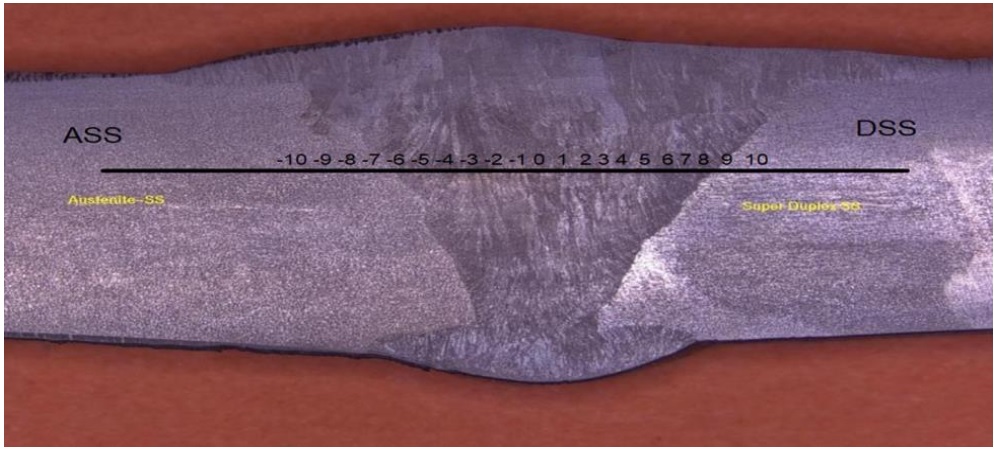Corrosion Behavior in Different Media of Dissimilar Super Duplex Stainless Steel 2507 and Austenitic Stainless Steel 316 Welding by Using GTAW Process with Filler Type 316L
DOI:
https://doi.org/10.51173/jt.v5i3.1103Keywords:
Dissimilar Welding, Super Duplex Stainless Steel Welding, Corrosion BehaviourAbstract
The Super duplex stainless steel is the best of the stainless steel types because duplex stainless steel contains two phases, ferritic and austenitic, which promote this alloy's mechanical and corrosion properties compared to other types. This study will investigate the corrosion behaviour of weld metal and base metals in acidic and salty media. At 20 C, hydrochloric acid (1M, 3M, and 5M) was studied beside sodium chloride NaCl (1 wt%, 3.5 wt%, and 5 wt%). The potentiostat test results show that the effect of HCl is more aggressive than NaCl in all cases, as HCl is a strong acid. The results showed the 316 base metal being the weakest area compared with others (2507 BM and W.M.). The microstructure has been checked before and after the corrosion test and pitting corrosion has been found in the 316 base metal only, while the weld metal and 2507 base metal surfaces were free of pitting influence. Due to the welding technique and using a cooper back strip, the microstructure shows minor grain growth in the heat-affected zones (HAZ) on both weld sides. The micro-hardness test revealed that the duplex stainless steel had a higher value than the weld metal and the 316-base metal. The weld metal had a minor increase over the base metal because of the migration of the elements like chromium and nickel.
Downloads
References
Aristotile, R., Barteri, M., & Fersini, M. Weldability of duplex stainless steel using tungsten inert gas (TIG) and submerged‐arc welding. Welding international, 7(5), 351-357, 1993, https://doi.org/10.1080/09507119309548405.
E. M. Westin, ‘Welds in the lean duplex stainless steel LDX 2101 : effect of microstructure and weld oxides on corrosion properties’, Licentiate dissertation, KTH, Stockholm, 2008.
A. Vinoth Jebaraj, L. Ajaykumar, C. R. Deepak, and K. V. V. Aditya, “Weldability, machinability and surfacing of commercial duplex stainless steel AISI2205 for marine applications – A recent review,” Journal of Advanced Research, vol. 8, no. 3. Elsevier B.V., pp. 183–199, May 01, 2017. doi: 10.1016/j.jare.2017.01.002.
H. Tan, Y. Jiang, B. Deng, T. Sun, J. Xu, and J. Li, “Effect of annealing temperature on the pitting corrosion resistance of super duplex stainless steel UNS S32750,” Mater Charact, vol. 60, no. 9, pp. 1049–1054, Sep. 2009, doi: 10.1016/j.matchar.2009.04.009.
Plaut, R. L., Herrera, C., Escriba, D. M., Rios, P. R., & Padilha, A. F. A short review on wrought austenitic stainless steels at high temperatures: processing, microstructure, properties and performance. Materials Research, 10, 453-460, 2007, https://doi.org/10.1590/S1516-14392007000400021.
Verma, J., & Taiwade, R. V. Dissimilar welding behavior of 22% Cr series stainless steel with 316L and its corrosion resistance in modified aggressive environment. Journal of Manufacturing Processes, 24, 1-10, 2016, https://doi.org/10.1016/j.jmapro.2016.07.001.
Sathe, S. S., & Harne, M. S. Optimization of process parameters in tig welding of dissimilar metals by using activated flux powder. International Journal of Science and Research (IJSR), 4(6), 7064, 2013.
Satelkar, D. S., Jogi, B. F., Thorat, S. B., & Chavan, A. A. Activated pulsed-tungsten inert gas welding of DSS 2205. In Techno-Societal 2018: Proceedings of the 2nd International Conference on Advanced Technologies for Societal Applications-Volume 2 (pp. 511-521). Springer International Publishing, 2020, https://doi.org/10.1007/978-3-030-16962-652.
A. Rustandi, S. Setiawan, and I. Fathurrahman, “The effect of sodium chloride concentration on corrosion resistance of austenitic stainless steel 316L and SMA weldment,” in Solid State Phenomena, vol. 263 SSP, pp. 120–124, 2017, doi 10.4028/www.scientific.net/SSP.263.120.
Oguike, R. S. Corrosion studies on stainless steel (FE6956) in hydrochloric acid solution. Advances in Materials Physics and Chemistry, vol. 04, no. 08, pp. 153–163, 2014, doi: 10.4236/ampc.2014.48018.
American Society of Mechanical Engineers (ASME), “Nondestructive Examination Boiler and Pressure Vessel Code An International Code”, SECTION V ASME, Annual book of ASME standards, 2017.
American Society of Mechanical Engineers (ASME), “ASME Boiler and Pressure Vessel Code, Section IX-Welding, Brazing and Fusion Qualification”, SECTION IX ASME, Annual book of ASME standards, 2017.
Lippold, J. C. (2014). Welding metallurgy and weldability. John Wiley & Sons.
Fan, R., Zhang, W., Wang, Y., Chen, D., & Zhang, Y. Metal material resistant to hydrochloric acid corrosion. In Journal of Physics: Conference Series, Vol. 1732, No. 1, p. 012134, 2021, IOP Publishing, doi: 10.1088/1742-6596/1732/1/012134.

Downloads
Published
How to Cite
Issue
Section
License
Copyright (c) 2023 Abdulrahman H. Abbood, Mohammed Helan Sir, Nasri S. M. Namer

This work is licensed under a Creative Commons Attribution 4.0 International License.
















